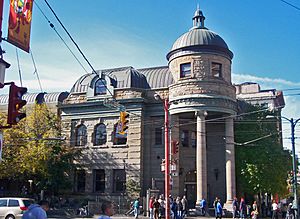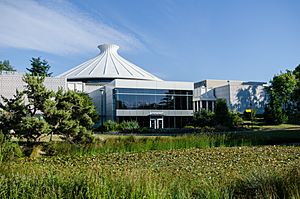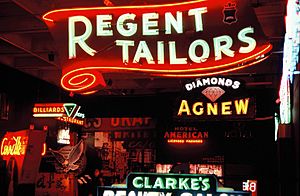Museum of Vancouver facts for kids
 |
|
| Established | 1894 |
|---|---|
| Location | Vancouver, British Columbia, Canada |
| Type | Civic museum |
| Visitors | 78,101 (2018) |
The Museum of Vancouver (MOV) is a history museum in Vancouver, British Columbia. It's located in Vanier Park. It's the biggest city museum in Canada and the oldest in Vancouver!
The museum started way back in 1894. It changed its name a few times before becoming the Museum of Vancouver in 2009. It shows exhibits and programs about Vancouver's past, present, and future.
The MOV shares an entrance with the H. R. MacMillan Space Centre. However, the museum is much larger. It takes up most of the building where both places are located.
The Museum of Vancouver wants to be a place where people can connect, learn, and have new experiences about Vancouver's many communities and stories. The MOV has about 80,000 items in its collection. About 90% of these items have pictures online for everyone to see.
The museum works to return items that belong to Indigenous Peoples. It made a special plan for this in 2006, which was updated in 2020. In 2025, the MOV opened an exhibit called The Work of Repair: Redress and Repatriation at the Museum of Vancouver. This exhibit shows how the museum is working to return items and connect with Indigenous communities.
Contents
History of the Museum
How the Museum Started
The museum was started by a group called the Art, Historical, and Scientific Association of Vancouver (AHSA). They formed on April 17, 1894. Their goal was to help people enjoy "the beauties and refinements in life."
Soon after, the AHSA opened its first small exhibit. It was called 'Paintings and Curiosities' and was in a rented space. People started donating items to the museum's collection. These were mostly things from nature or different cultures. The first recorded donation was a stuffed Trumpeter Swan in 1895.
The museum began buying items regularly in 1898. They collected all sorts of things. This showed what the people making decisions were interested in, not a specific plan.
As the collection grew, the museum needed a permanent home. After talking with the Vancouver City Council, they agreed on August 26, 1903. The museum's collection would belong to the City Council. In return, the Council would provide a good place to display the items. They decided the new museum would be on the top floor of the new Carnegie Library. The museum opened there on April 19, 1905.
Moving and Growing
Between 1915 and 1925, the museum tried to build a recreated First Nations village in Stanley Park. It was planned around large totem poles and house poles the museum had collected. This project didn't work out. However, it led to the totem poles you can see in Stanley Park today. They are a very popular tourist attraction in Vancouver.
In 1930, the museum helped with big archaeological digs at the Great Marpole Midden. This was a very important ancient site on the Pacific Northwest Coast. It was also the traditional land of the Musqueam First Nation. The village of c̓əsnaʔəm (Musqueam Marpole Village Site) was once there. This work led to a special exhibit called c̓əsnaʔəm, the city before the city. It was a joint project with the Musqueam Indian Band, the Museum of Vancouver, and the Museum of Anthropology.
In 1957, the public library that shared the Carnegie building moved to a new building. This gave the museum three times more space for storage and exhibits. In 1959, the museum became part of the City Council. It was then run by a Civic Museum Board.
A report in 1965 suggested building a new museum. It recommended a spot near the Burrard Bridge. Money was available for the 1967 Confederation Centennial celebrations. The current museum building was built and opened to the public in October 1968. From 1968 to 1981, the museum was called the Centennial Museum. Then it changed its name back to Vancouver Museum.
In 1972, the city council gave up control of the museum. A new group, the Museum and Planetarium Association, was formed. This group was like the original AHSA that started the museum. In 1977, the government recognized the museum as an important cultural place.
In 2009, the museum changed its name again to the Museum of Vancouver. This was to show that it now focused more on the city of Vancouver itself.
The Museum Building
The museum building is at 1100 Chestnut Street in Vanier Park, Vancouver. It's at the south end of Vanier Park. The park connects the Vancouver Maritime Museum, Bard on the Beach, the Vancouver Archives, and the Vancouver Academy of Music.
The building was built in 1967. It was designed by architect Gerald Hamilton. He was known for a style called New Formalism.
At first, the building was only planned for the museum. But a generous gift from H.R. MacMillan allowed a planetarium to be added. The unique roof was designed to look like a woven basket hat made by Northwest Coast First Nations people. However, it also looks like a flying saucer! This has caused confusion, with many people thinking the building is only the planetarium. But most of the building is actually the Museum of Vancouver. The planetarium was renamed the H. R. MacMillan Space Centre in the late 1990s.
The building was officially opened on May 20, 1967. Princess Alexandra attended the ceremony. She was a cousin of Queen Elizabeth II.
The building is considered a famous landmark in Vancouver. It was nicknamed 'the Taj Mahal on the creek' when it was first built. It has a sweeping cone shape and reflecting pools with curved bridges.
Museum Collections
The museum has a very large collection of objects. Many of these items were donated by people or chosen by curators over the years. The collection is important for the whole country. However, many items are kept in storage because there isn't enough space to display them all.
The collection includes First Nations and Asian artifacts. These were collected by Mary Lipsett. She and her husband opened the Lipsett Indian Museum in 1941. Her collection was said to be the best in Canada in 1948. Mary Lipsett was respected for her good relationships with First Nations people. She was even given the Kwawlewith name 'Ha-wini-po-la-o-gua'. This means “a matriarch to whom many come for good counsel.” She donated her entire collection to the Vancouver Museum, and it is still stored there.
Here are some of the strong points in the MOV collection:
First Nations Collections
This is one of the most important collections of Pacific Northwest Coast First Nations items in Canada. It includes:
- Argillite carvings
- Small wooden carvings (like mini totem poles)
- Large wooden sculptures (like totem poles and house posts)
- Many baskets, including those from the Nuu-chah-nuith and Coast Salish peoples
- Objects carved by Charles Edenshaw, including the Edenshaw Casket
- Glass slides painted by Frederick Alexcee
- A basket and bracelet collected by George Vancouver on his first trip to the Pacific Northwest
- Masks, boxes, bowls, canoes, and other special items
- Pauline Johnson's performance costume
- Human seated figure bowls and other carvings of people or animals made from stone
Asian Art and Objects
These collections include:
- Chinese art objects from ancient times (Shang dynasty, 16th-11th century BCE) to the Qing dynasty (1644-1911). This includes a large collection of ceramics, coins, ivory carvings, jade carvings, and textiles.
- Japanese objects from the Muromachi period (1392-1572) to the Meiji period (1868-1912). This includes woodblock prints, ceramics, ivory carvings, textiles, armor, swords, and dolls. The collection of over 400 sword guards is the best public collection in Canada.
- Indian, Nepalese, and Tibetan sculptures, textiles, and paintings from the 16th to 20th century.
- Thai bronze Buddhist statues, scriptures, textiles, and ceramics from the 12th to the 20th century.
- Ceramics from Vietnam and Cambodia.
Ancient Egyptian Items
These include:
- An ancient Egyptian collection, especially a mummified boy. He was found near the Valley of the Kings in 1915. His mummy wrappings say "Penechates, son of Hatres." He likely lived between the 1st and 3rd century CE.
- Mummified crocodiles, hawks, and cats.
- Items found by Sir Flinders Petrie, who was on the Vancouver Museum Board in 1934.
History of Vancouver Items
These include objects like:
- Furniture and items related to important people, city events, and buildings.
- Edwardian household items, including beautiful stained glass made in Vancouver.
- Street items like signs, street lamps, and mailboxes from Vancouver.
- Items related to Chinatown and the Chinese community, especially from the Yip Family Collection.
- Tools, equipment, and furnishings from Vancouver shops, businesses, and industries.
- Women’s clothing, shoes, and accessories worn or made in Vancouver from about 1870-1980.
- Toys, dolls, and children’s clothing used in Vancouver from about 1890-1980.
- Objects used for communication in Vancouver from about 1890-1970.
- Paintings by early Vancouver artists from the 1900s-1930s.
- Objects related to major events like Habitat 76, EXPO 86, the 1990 Gay Games, and the 2010 Olympic Games.
- Items related to Rogers Sugar Refinery.
- Uniforms, accessories, and badges related to public transit in BC.
- A large collection of neon signs.
Museum Galleries
The museum has several permanent galleries. They cover the entire history of Vancouver with sounds and films. Besides the historical galleries, permanent galleries at the Museum of Vancouver include:
- c̓əsnaʔəm The City Before the City
- "That Which Sustains Us"
- 1900s–1920s History Gallery: Gateway to the Pacific
- 1930s–1940s History Gallery: Boom, Bust, and War
- 1950s History Gallery: Vancouver in The Fifties
- 1960s–1970s History Gallery: You Say You Want A Revolution
Most of these galleries explore Vancouver's history during specific time periods. The Neon Vancouver gallery features a collection of neon signs used in Vancouver from the 1950s to 1970s. This exhibit ended in 2022.
The Museum of Vancouver also hosts temporary exhibitions. For example, the c̓əsnaʔəm, the city before the city exhibition was created with the Musqueam Indian Band. It was at the museum from January 2015 to January 2021. Another exhibition, HAIDA NOW: A Visual Feast of Innovation and Tradition, opened in March 2018 and ran until June 2021. The exhibition Acts of Resistance opened on February 5, 2020, and ran until December 2020.




